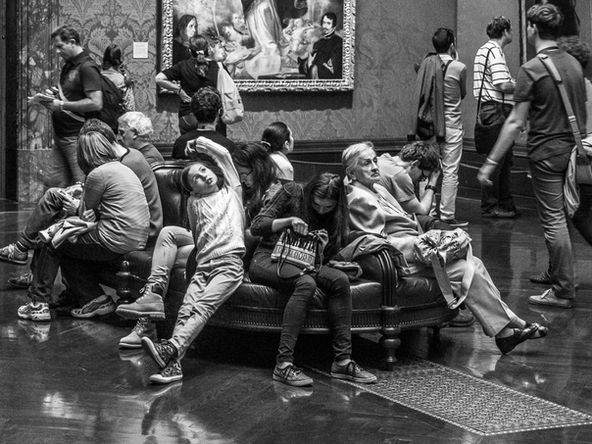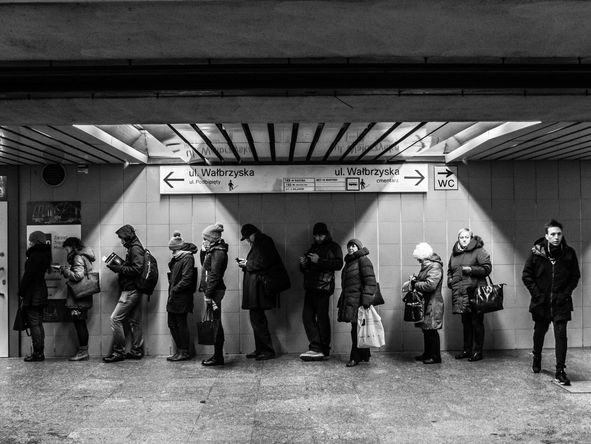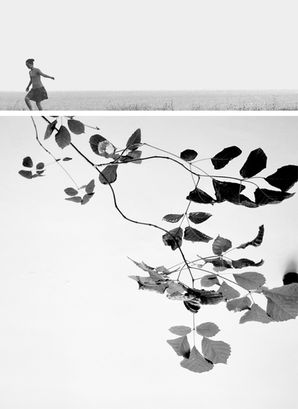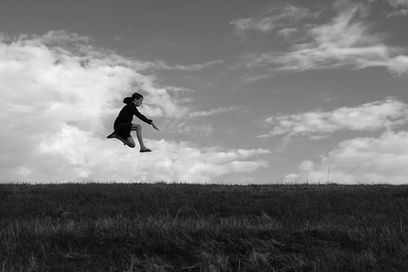
LIFE IN MY CITY
April 19, 2021
INTERVIEW
PHOTOGRAPHY Grzegorz Zukowski
INTERVIEW Melanie Meggs
In a world filled with chaos and disorder, one street photographer finds solace in expressing himself through his lens. Grzegorz Zukowski, a Polish photographer, has been capturing the essence of everyday life on the streets of his home country for years. His photographs are unique in their composition and subject, capturing moments that are both accidental and deliberate. For Grzegorz, street photography is an opportunity to explore his personal beliefs about life in the city, while also celebrating its beauty and complexity. Through his work, Grzegorz is able to express his love for simplicity, order, peace and convenience, while finding freedom and spontaneity in the unexpected. With each photograph, Grzegorz crafts a story that allows viewers to immerse themselves in his perspective and experiences. Through his lens, he reveals a deeper understanding of the world and offers a glimpse into his personal journey as a street photographer.

“Freedom is the strategy of making chance and necessity subordinate to human intention. Freedom is playing against the camera. We, photographers, if we want to show human condition, include what is informative in images, we have to smuggle human intentions into the program that are not predicted by it, force the camera to create the unpredictable, the improbable. I definitely want to say that I photograph to feel free.”
IN CONVERSATION WITH GRZEGORZ ZUKOWSKI
THE PICTORIAL LIST: Grzegorz please tell us about yourself. How did you become interested in photography?
GRZEGORZ ZUKOWSKI: I live in Warsaw, Poland and I was born in this city. I'm now in my thirties. I became interested in photography when I was in my twenties as a student at the University of Warsaw. As I chose the specialisation of reportage and documentary. The lecturer on these workshops was one of the better known photo editors in photographic community in Poland back then, Iza Wojciechowska.
Iza encouraged many people to become photographers and I'm very proud to be one of them. I think she had great teaching abilities and her reactions on our photographs and assignments she gave us, and how we talked about photographs were very inspiring. She noticed my photographs and perhaps felt how eager I was to do them, and after one of the workshops we had a short chat about photography. I think even though she simply said to me - "you see the light, so you can photograph and perhaps see what others can't" - reflecting on this, it has meant a lot to me. So I photograph.
I also attended photographic studies of Polish Association of Artist-Photographers in Warsaw in 2011-13. After that I grew my interest in street photography, which I think came to me naturally as I was photographing in my spare time. But I think also because I was always interested in observing people in an urban space.
I am a graduate of political science and journalism on the University of Warsaw. I was working as a Public Relations Specialist and now I am a Digital and Social Media Specialist with Amnesty International.
TPL: Where do you find your inspiration?
GZ: Everywhere. Maybe it will be a banal to say, but I just think the inspiration is everywhere and it is hard to tell for me where is that one specific place where I can find it. One finds it definitely a careful observation of oneself. The creative act, whether in photography or in any other creative genre, I think always includes the necessity to look at our own emotions, our personalities, question how we react to the things we interact with and why are we doing something. So the inspiration is our life experience and reflection on it.
For example recently, the Women's Strike demonstrations in Warsaw were some great inspiration for me as strong emotions related to them as something unfair and cruel was happening, in another sphere perhaps looking at the paintings of Edward Hopper as they might represent the feelings of loneliness, but overall the most important is constantly discovering and knowing yourself.
TPL: What is it that you enjoy about street photography? Explain your technique? What do you want to express through your photography?
GZ: When doing photography or street photography in particular, I am drawn by it with a sense of acting freely as an observer, but also as a careful participant that is safe to absorb the emotions of the people around. The camera is my shield. Though Gordon Parks, great photographer, mentioned that for him his camera is his weapon, but I like to add that having a shield is also important. Not only you want to point the camera to something that matters to you, but also it might help you to be present, to protect you from what might be harmful, disturbing for you.
What interests me in the frames is the simple composition and the subject - city and the people. When I organized my solo exhibition "Simplicity" in Warsaw in 2016, I wondered about urban life and doing street photographs, because of the contrasts I see. On the one hand you can say that urban life is spontaneous, random and chaotic. Similarly the photographer, when doing street photography, relies on intuition and on catching changeable, decisive moments. On the other hand human, when creating the urban space, is drawn by the need of order, convenience, simplicity. As well the street photographer in the frames arranges the space, catching elements, which are making a coherent composition. I wonder on this contrast – between something accidental, free, intuitive, spontaneous and the need of simplicity, order, peace and convenience.
Furthermore, perhaps to put it more personally, one can say the big city determines feelings of loneliness and alienation from other people and what is around us. At the same time the urban life does not make us feel alone, constantly making us connect with others. I think I am searching, when doing photography, for more or less quite scenes, being aware of loneliness, and at the same time doing photographs to feel connected, catching human interactions and creating relations between them each other and the space around them.
TPL: What is it like photographing on the streets of Poland? Do you have any favourite spots to go photographing? How has the pandemic affected you and your photography?
GZ: I live in Warsaw and mostly I photograph here, from time to time I travel to other cities to spend a day in order to just have a walk and photograph. Of course pandemic and frequent lockdowns and restrictions made me to be more careful about that. At some point a strict lockdown made Warsaw's city center even a desolated, strange place that was very interesting to photograph. Of course usually I'm drawn by the places where people are present frequently, though I can seek scenes that are showing quietness in these busy places.
What I think about the cities in Poland is that they're still an urge to modernise and in many ways it is good as it brings some improvements and revitalisation of attractive places. It is also good to see when local communities are taking the initiative to make their space more friendly and convenient. On the other hand there is always something in the past of these cities that is perhaps something more original in a eastern European manner, that contrasts with the need to modernise, in example when looking at the older architecture or sadly at the advertisement chaos. All of that of course can be used in street photographs.
I think that by most of the time, even if I'm influenced by the place I am photographing I hope to catch something universal out of it and the context of a place is not as important as the general subject - people and the city.
TPL: Do you have any favourite artists or photographers you would like to share with us, and the reason for their significance?
GZ: When attending photographic studies of Polish Association of Artist-photographers I spent a lot of time photographing in black and white and such great photographers like Henri Cartier-Bresson or Josef Koudelka stayed with me and I always like to get back to the books I have with their photographs. On the other hand there are masters of color like Saul Leiter or Fred Herzog that I really like. And to mention present photographers Nick Turpin's series "On the Night Bus" and Damian Chrobak "Everywhere I look I'm being looked at", also resonates with me. But there are so many great photographers nowadays that there wouldn't be a space here to mention all that I admire.
Maybe to emphasize that also other genres are important I recently got back to Edward Hopper's paintings and his sense of urban space and alienation of people in it sparks something in me or even gives me an impression of similarities in how he saw the space and how I photograph.
TPL: Do you have a favourite quote, lyric, or saying that especially resonates with you?
GZ: Not so long ago I encountered Vilém Flusser's philosophy of photography and it resonates with me how he underlines freedom as the key idea in photography. Let me quote here a short excerpt from "Towards a Philosophy of Photography":
"We observe, all around us, apparatuses of every sort in the process of programming our life through rigid automation (...)."
In short: Everything is becoming absurd. So where is there room for human freedom? Then we discover people who can perhaps answer this question:
"photographers. (...) They are already, in miniature, people of the apparatus future. Their acts are programmed by the camera; they play with symbols; they are active in the 'tertiary sector', interested in information; they create things without value. In spite of this they consider their activity to be anything but absurd and think that they are acting freely. The task of the philosophy of photography is to question photographers about freedom, to probe their practice in the pursuit of freedom(...)."
In short: Freedom is the strategy of making chance and necessity subordinate to human intention. Freedom is playing against the camera. These are words from 1980s. I think they're even more up to date now in even more technologised social life, where we are not creating images but we are being programmed by the them constantly.
We, photographers, if we want to show human condition, include what is informative in images, we have to smuggle human intentions into the program that are not predicted by it, force the camera to create the unpredictable, the improbable. I definitely want to say that I photograph to feel free.
What interests me in the frames is the simple composition and the subject - city and the people.

TPL: Does the equipment you use help you in achieving your vision in your photography? What camera do you use? Do you have a preferred lens/focal length?
GZ: I usually keep my equipment light and I limit myself to one lens. From some time I've been doing street photographs with a mirrorless camera and with a fixed 35mm manual lens. That just suits me fine. When I'm out on demonstrations and events I change to a lens that gives me wide angle but with a zoom, like 18-55mm. I rarely use flash, but if yes, only on events, like demonstrations. I think I have a need to keep it simple and not to be distracted by sophisticated gear. In limiting yourself you might find an easier way of achieving what you want or what you need.
TPL: When you go out photographing, do you have a concept in mind of what you want to shoot, or do you let the images just "come to you", or is it both?
GZ: What there is at the beginning might be only an idea of a short walk. On other occasions I plan carefully where to go, from one point of a city to another, than to another and then elsewhere. Of course it happens that I'm asked to photograph someone or I'm photographing a specific event, so I can prepare myself more carefully by writing down what I want to get out of it.
But all of these are more preparing myself to what is unexpected, that I can't foresee, while more important it seems is the road or the journey and not the goal itself. I like to think when photographing that I'm turning my mind to meditative kind a state, having a flow, that helps to calm down, observe, be careful, to absorb and be present. Actually what comes afterwards, when selecting and editing the photographs I've made, is the stage when a concept thinking happens. Because the photographs in this moment can reveal to me some emotions I might also have to what I photographed and a stream of thoughts and loose associations might occur and all of that can lead to decisions what photographs to publish, what to put in black and white and what in color, what might go in a series of some kind or what to leave for a while.
TPL: Have you ever been involved in the creative world before photography?
GZ: No, though when being a student I thought that writing will be a genre that I'll be improving and by this way trying to express myself. But discovering photography changed that. Though I like comparing these two things even if they seem completely different, yet we often put them together when illustrating a text with an image, or often say that one image can say thousands of words. I think Elliot Erwitt put it right, when he mentioned that a good photograph is when you want to get back to it over and over again like to a catchy line of a great poem.
TPL: What are some of your goals as an artist? Where do you see yourself or hope to see yourself in five years?
GZ: The street photography is a kind of a constant project for me, a stream of consciousness, that sometimes reveal to me some ideas. Like in 2016 I organized my solo exhibition titled "Simplicity" with some of my black and white photographs. I hope that in the future I'll publish them in some form in a concept, idea, that perhaps is evolving slowly, even when answering your questions in this interview.
Meanwhile it seems that the situation in Poland will be a source of photographs, when social and political situation makes people to go out on to the streets, protest and organise in movements. That is something that also draws my attention and I want to be part of it, definitely as a careful observer. The people and their emotions is something that I'll try to turn my attention more to as I like to portray people and perhaps I do it in most of the times candidly anyway, but I think I'll try to improve posed photography.
TPL: Are there any special projects you are currently working on that you would like to let everyone know about?
GZ: Perhaps nothing specific at this very moment, but with a stack of a lot of material to do something with. The women's strike protests in Poland and in general demonstrations throughout recent years has brought so many interesting stories, emotions to tell, that I will think about it more and still try to document it.
TPL: When I am not out photographing, I (like to)…
GZ: To be inspired, I like to have a cup of a good coffee, good read, good movie series to watch and great music to listen to and perhaps that all comes down to a banal, that I like to think the world is beautiful.

Grzegorz Zukowski's street photography is a unique and powerful form of self expression. His eye for composition and his desire to capture something accidental, free, intuitive and spontaneous is evident in his work. By combining simplicity, order, peace and convenience, he creates a reflection on his own personal thoughts about life in the city. To view more of Grzegorz's stunning photography and gain insight into his personal reflections on city life, use the links below.



































